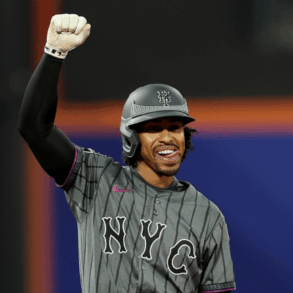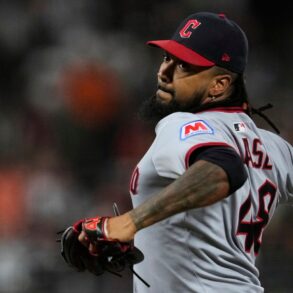Sunday’s out-of-left-field trade of Rafael Devers wasn’t only a mind-bender from the Boston Red Sox perspective.
Devers’ dynasty and keeper league managers also face frustrating future prospects as a result of the move. A 30-HR hitter in three and 400-point fantasy scorer in four of the past five uninterrupted seasons, Devers’ role and run production is suddenly in greater question, largely because of his new home ballpark.
San Francisco’s Oracle Park, despite the changes that somewhat shrunk its dimensions between the 2019 and 2020 seasons, is one of baseball’s most pitcher-friendly venues. In the four complete campaigns since the team trimmed five feet from its fence distances in left-center, six in right-center and eight in dead center field, the venue has placed among the seven worst in baseball in terms of home run factor per Statcast (which compares the San Francisco Giants and their opponents’ numbers at home to on the road in the given season) and 14th or worse in runs scored in three of those four years.
To put it in a player-oriented way, consider that Barry Bonds is the most recent Giant to have hit 30 home runs in a season, doing so way back in 2004. In the 19 seasons since, an MLB-fewest six Giants have managed as many as 100 runs created in a single year: Pablo Sandoval (121 in 2009), Buster Posey (117 in 2012), Aubrey Huff (114 in 2010), Brandon Belt (108 in 2016), Hunter Pence (102 in 2013) and Randy Winn (101 in 2008). By way of comparison, the 2007 New York Yankees roster alone had as many 100-RC hitters, and 21 of the 29 other teams have had at least three times as many 100-RC seasons as the Giants have had during that time span.
This isn’t to say that Devers’ power is destined to die by the San Francisco Bay. Home runs might be the one category in which his production should remain stable. Over the past five seasons (2021-25), Devers should have been expected to hit 129 total home runs if he played the entirety of his games at Boston’s Fenway Park, but he would have hit 142 homers if he had called Oracle Park his home. Additionally, the fact he has registered at least a 92nd percentile Barrel rate in four of the last six seasons (2025 included), and at least a 92nd percentile hard-hit rate in each of his last five, supports his raw power being good enough to clear most any outfield fence.
However, the advantages Fenway Park provides a hitter in terms of hit rate, and most importantly extra-base production, are what Devers is sure to miss. The Red Sox, by the way, have an MLB-leading 40 player seasons with 100-plus runs created since that 2004 Bonds campaign, which can’t be entirely a matter of better hitting personnel.
Throw in the fact that Devers’ long-term positional assignment is no clearer in San Francisco than it was in Boston, and there’s legitimate concern that we’ve already seen his best from a dynasty and keeper perspective. A DH for all 73 of his appearances before the trade (all of them starts), he’s unlikely to unseat defensive whiz Matt Chapman at third base. Plus, the Giants have a potentially elite first base prospect in Bryce Eldridge less than a year away from being ready for the majors. Devers might sneak in enough games at third base to qualify there for 2026, if he can sneak in enough time there before Chapman returns from his current hand injury, but if he falls short, we might be looking at a permanent DH-only.
A player I was once in love with for dynasty purposes — he peaked at No. 7 overall in my mid-2020 Dynasty 300 rankings, ranked 23rd overall in my March update, and was the starting third baseman on both my “All-2025” and “All-2026 Teams” — Devers is unlikely to remain that cornerstone in San Francisco. Junior Caminero of the Tampa Bay Rays, for example, is now a more preferable player in those formats, and Devers would more likely be a top-40 (as opposed to a top-25) player going forward.
This is something to be tucked away even in redraft formats, should you be presented with the right trade offer accounting largely for his past, lofty Red Sox numbers.
Devers isn’t the only 2025 “team-changer” whose dynasty value has suddenly come into question as a result of his home ballpark. Juan Soto has fallen noticeably short of preseason expectations in his first season with the New York Mets, though he has picked up the pace with .351/.519/.737 rates and six home runs over his past 17 games. For the season, however, the player commonly projected to contend for the most fantasy points among hitters places seventh — and 68 points behind his 2024 teammate, Aaron Judge.
Citi Field’s spacious confines have surely had something to do with Soto’s performance, as he’s been a mere .238/.361/.462 hitter there this season, disappointing home numbers that fall right in line with his more ordinary rates from 2022-23, when he called San Diego’s similarly pitcher-friendly Petco Park his home for 105 combined games. Citi Field, for the record, has ranked 22nd or worse for runs scored in four of the last five seasons (2021-23 and ’25).
This isn’t to say that Soto is destined to plummet in the dynasty rankings, not by a long shot. Thanks to his elite combination of patience, contact and power — he has had at least 99th percentile Statcast hard-hit and at least 98th percentile chase rates in each of the last three years (2023-25) — he’s baseball’s best high-floor hitter for both points league and sabermetric play. A 26-year-old, he’s as good a bet (and I’d declare better than most) to clear 450 fantasy points in each of the next five seasons as anyone in baseball.
However, in rotisserie leagues or if you’re in the draft chair and hoping for a top-shelf, 500-plus-point campaign with your first-round pick, do you want the guarantee of 450 points or to shoot for the moon? I tend to go with the higher floor, but if Soto’s reign of .300-plus hitting, or 40-plus HR seasons are more in his rearview, it’s reasonable to field trade offers to deepen your roster elsewhere.
Dynasty hitters on the rise
Today’s column isn’t meant to be a downer! Here are two hitters who, based upon how they’ve looked so far in 2025, might be on the verge of becoming true building-block pieces in the format. That’s something to tuck away for redraft play as well, should you have an opportunity to acquire either for a reasonable price.
Riley Greene, OF, Detroit Tigers: On the whole, fantasy managers don’t seem to appreciate the incremental gains he has made over the past two-plus years, but if his Tigers hang onto the AL Central lead and possibly even challenge for the league’s best record, you can be sure that he’ll get much more attention.
Greene’s injury history — three IL stints totaling 90 days missed over the past two seasons alone — might be what scares some off, but be aware that in this, a modest breakthrough campaign, he ranks sixth in Barrel rate and is enjoying a third consecutive season in at least the 80th percentile in hard-hit rate. He’s also batting .305/.366/.576 with 12 home runs across his last 47 games. Yet, incredibly, he remains available in 18.4% of ESPN leagues. That needs to be corrected immediately.
Oneil Cruz, SS/OF, Pittsburgh Pirates: On that same Barrel-rate leaderboard, you’ll find Cruz ranked second, only 0.7% behind leader Aaron Judge. And to underscore Cruz’s immense caliber of raw tools, he’s first in average exit velocity, second in hard-hit rate, first in arm strength and ranked in the 91st percentile in sprint speed.
Cruz’s .223 batting average and 32.6% strikeout rate are the only things holding him back from complete superstardom, but in rotisserie leagues, we’re already on board with him being a borderline first-round talent. Like Devers and Soto, Cruz is held back by his pitcher-friendly home ballpark since PNC Park is every bit as bad an environment for home runs as Oracle Park. Still, if he continues to exhibit the level of greater selectivity that he has thus far, he’s on the doorstep of universal top-15 overall fantasy value.
This post was originally published on this site be sure to check out more of their content.







